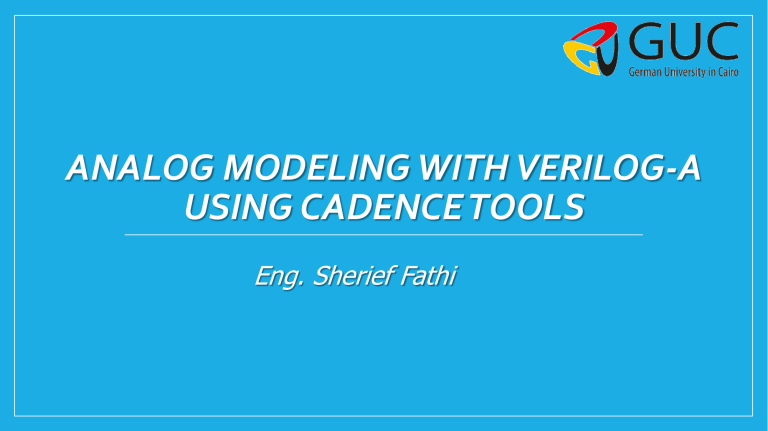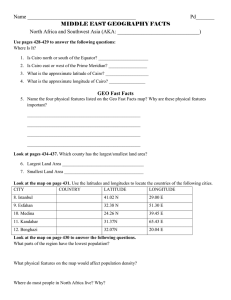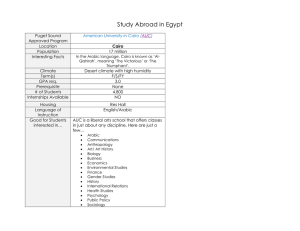
ANALOG MODELING WITH VERILOG-A
USING CADENCE TOOLS
Eng. Sherief Fathi
Hardware Description Language (HDL)
• In
electronics, a hardware description language (HDL) is a
specialized computer language used to describe the structure
and behavior of electronic circuits.
• Two HDLs used today:
VHDL and Verilog
Both are industrial standards and are supported
by most software tools.
German University in Cairo
2
Verilog-AMS
•
•
•
Combines Verilog, ...
Discrete-event / discrete-value simulation
Verilog-A, …
Continuous-time / continuous-value
simulation
Signal flow modeling
Conservative modeling
And some extras
Discrete-event / continuous value
simulation
Automatic interface element insertion
Digital
Analog
System
System
Gate
Circuit
Verilog
Verilog-A
Verilog-AMS
Mixed-Level Simulation (MLS)
10000
9000
8000
7000
6000
5000
4000
3000
2000
1000
0
IBS 2001
Mixed-Signal
Digital
German University in Cairo
4
Verilog-A
• Able to model analog circuits and systems
- Signal-flow models
Model relates potentials only
Useful for abstract models
- Conservative models
Model relates potentials and flows
Device modeling and loading at interfaces
German University in Cairo
5
+
a
V(a,b)
I(a,b)
–
Flow
Potential
Potentials and Flows
b
Resistor
module resistor (a, b);
electrical a, b;
parameter r = 1;
analog
V(a,b) <+ r*I(a,b);
endmodule
Conservative
Model
(potential & flow)
Amplifier
Potential
+
V(out)
–
Potential
+
V(in)
–
module amp (out, in);
output out; input in;
voltage out, in;
parameter a = 1;
analog
V(out) <+ a*V(in);
endmodule
German University in Cairo
Signal-Flow
Model
(potential only)
6
Declaring Modules
module mymod(p,n);
.............
endmodule
German University in Cairo
7
Ports
module modName(outPort1, outPort2, inPort, bidirectional);
output outPort1;
output [3:0] outPort2;
input inPort;
inout bidirectional;
electrical outPort1, [3:0] outport2, inPort, bidirectional;
……
endmodule
German University in Cairo
8
Constants
• parameter real
res = 5e3 from (0:inf);
• parameter real
percentage = 0.7 from [0:1];
• parameter integer
• parameter real
N = 4 from (0:inf);
poles[0:3] = { 1.0, 3.198, 4.554, 2.00 };
• parameter string transistortype = "NPN" from { "NPN", "PNP" };
German University in Cairo
9
Variables
• integer a[1:64];
// an array of 64 integer values
• real float;
// a variable to store real value
• real gain_factor[1:30];
// array of 30 gain multipliers
German University in Cairo
10
Signal Access on Nodes, Ports, Branches
• To get (probe) values: use access function in expression
• x gets voltage between a and ground:
x = V(a)
• x gets voltage between a and b:
• x gets current between a and ground:
• x gets current between a and b:
x = V(a,b)
x = I(a)
x = I(a,b)
• To set (source) values: use access function as target in contribution
• set voltage between a and ground to x:
V(a) <+ x
• set voltage between a and b to x:
• set current between a and ground to x:
• set current between a and b to x:
German University in Cairo
V(a,b) <+ x
I(a) <+ x
I(a,b) <+ x
11
The Contribution Operator : ‘<+’
•
Accumulates potentials or flows to nodes, ports, and branches
•
Order of contribution is not significant
module rlc (a, b);
electrical a, b;
parameter R = 1 exclude 0;
parameter C = 1;
parameter L = 1 exclude 0;
analog begin
I(a,b) <+ V(a,b) / R;
I(a,b) <+ C*ddt(V(a,b));
I(a,b) <+ idt(V(a,b) / L;
end
endmodule
German University in Cairo
12
Assignment vs Contribution
•
Example1:
module test(p,n) ;
inout p,n;
electrical p,n;
parameter integer a = 2;
real r;
analog
begin
r=a; // Now r=2
r=2*a; // The value of r is updated to r=4
V(n) <+ a; // This equation contributes by a value a , V(n) =a=2;
V(n) <+ 2*a; // A new contribution is added to V(n) ,
end
V(n) = a+2a =6;
endmodule
German University in Cairo
13
Operators
Arithmetic Operators
+, -, *,**, /, %
Relational Operators
<, <=, >, >=
Equality Operators
==, !=, ===, !==
Logical Operators
!, &&, ||
Bit-Wise Operators
~, &, |, ^, ~^
Unary Reduction
&, ~&, |, ~|, ^, ~^
Shift Operators
>>, <<
Conditional Operators
?:
Concatenations
{}
German University in Cairo
14
Analog Operators
•
Differentiator: ddt()
Time derivative of its argument
•
Integrator: idt()
Time integral of its argument
Optional initial condition
•
Circular integrator: idtmod()
Time integral of its argument passed through modulus
operation
•
Time delay: absdelay()
Delayed version of its argument
German University in Cairo
15
Standard mathematical functions
German University in Cairo
16
Trigonometric and hyperbolic functions
German University in Cairo
17
If Statement (SWITCH)
Example 1
if (x1 >= 2) begin
x2= 5*x1;
end
else if (x1<5) begin
x2= x1/2;
end
else begin
x2 = x1;
end
Example 2
if(analysis("ic"))
begin
x2= init_cond;
end
else if(analysis("tran"))
begin
x2= x1/2;
end
German University in Cairo
18
Example: Resistor and Conductor
Resistor (potential source branch)
+
–
•
i
analog
V(a,b) <+ r*I(a,b);
endmodule
Conductor (flow source branch)
v
+
–
•
v=ri
module res (a, b);
electrical a, b;
parameter real r = 1;
i=gv
module cond (a, b);
electrical a, b;
parameter real g = 1;
analog
I(a,b) <+ g*V(a,b);
endmodule
German University in Cairo
19
Example: Capacitor and inductor
•
Capacitor
module cap (a, b);
electrical a, b;
parameter c = 1;
analog
I(a,b) <+ C*ddt(V(a,b));
endmodule
•
inductor
module ind (a, b);
electrical a, b;
parameter L = 1;
analog
V(a,b) <+ L*ddt(I(a,b));
endmodule
German University in Cairo
20
Example: Multiplier
//VerilogA for a multiplier,
output out;
`include "constants.vams"
electrical in1,in2,out;
analog begin
`include "disciplines.vams“
module multiplier(in1,in2,out);
input in1,in2;
V(out) <+ V(in1) * V(in2);
end
endmodule
German University in Cairo
21
Inserting Verilog-A model into Cadence
•
Open Cadence then change the editor:
editor=“gedit”
German University in Cairo
22
Inserting Verilog-A model into Cadence
•
From the library manager, create a “new cell view” with a type: “veriloga”
German University in Cairo
23
Inserting Verilog-A model into Cadence
•
Insert the VerilogA code:
German University in Cairo
24
Inserting Verilog-A model into Cadence
•
Choose highlight mode > verilog
German University in Cairo
25
Inserting Verilog-A model into Cadence
•
Insert the VerilogA code, save the file, and close.
1. If the model does not has a syntax error, you will be asked to create a
symbol.
2. If the model has a syntax error, open the error log to identify errors and
solve it.
German University in Cairo
26
Inserting Verilog-A model into Cadence
•
Define the directions of the pins i.e. : left, right, top, or bottom
German University in Cairo
27
Inserting Verilog-A model into Cadence
•
Modify the symbol “optional”, then Check & Save
German University in Cairo
28
Inserting Verilog-A model into Cadence
•
Now you can test your model by creating a new cell view of type “Schematic”,
and make a simple test circuit:
German University in Cairo
29
Inserting Verilog-A model into Cadence
German University in Cairo
30
Inserting Verilog-A model into Cadence
German University in Cairo
31
Example B: TEAM Memristor model
http://webee.technion.ac.il/people/skva/Memristor%20Models
/TCAS_memristor_model_paper_final.pdf
German University in Cairo
32
Example B: TEAM
Memristor model
Note: You can access the parameters’ values
from the schematic directly
German University in Cairo
33
Some useful links
• Verilog-AMS Manual
• Verilog-A model library at
German University in Cairo
34
German University in Cairo
35
German University in Cairo
36
Operators
German University in Cairo
37
Verilog-AMS
•
Combines Verilog, ...
• Discrete-event / discrete-value simulation
•
Verilog-A, …
• Continuous-time / continuous-value simulation
• Signal flow modeling
• Conservative modeling
•
And some extras
• Discrete-event / continuous value simulation
• Automatic interface element insertion
38
CADENCE DESIGN
SYSTEMS, INC.
Named Branches
• Named branches are explicitly declared
• Useful when defining distinct parallel potential branches
module rlc (a, b);
electrical a, b;
parameter R = 1, C = 1, L= 1;
branch (a, b) res, cap, ind;
analog begin
V(res) <+ R*I(res);
I(cap) <+ C*ddt(V(cap));
V(ind) <+ L*ddt(I(ind));
end
endmodule
39
CADENCE DESIGN
SYSTEMS, INC.
Example: Capacitor with Initial Condition
module cap (a, b);
electrical a, b;
parameter real c=0, ic=0;
analog begin
if (analysis("ic"))
V(a,b) <+ ic;
else
I(a,b) <+ ddt(c*V(a,b));
end
endmodule
40
CADENCE DESIGN
SYSTEMS, INC.
German University in Cairo
41
Accessing Net and Branch Signals
•
Examples
Vin = V(in);
CurrentThruBranch = I( myBranch );
•
Indirect branch assignment
An indirect branch assignment is useful when it is difficult to solve an equation. It has this
format,
V(n) : V(p) == 0;
which can be read as "find V(n) such that V(p) is equal to zero."
German University in Cairo
42
Operator Precedence
[ ]
bit-select or part-select
( )
!, ~
parentheses
logical and bit-wise
negation
>, >=, <, <=
relational
==, !=
logical equality
&
bit-wise AND
^, ^~, ~^ bit-wise XOR and XNOR
&, |, ~&, ~|, ^, ~^, ^~
reduction operators
|
bit-wise OR
+, -
unary arithmetic
&&
logical AND
{ }
concatenation
||
logical OR
*, /, % arithmetic
+, -
arithmetic
<<, >> shift
?:
conditional
Analog operators and equations
•
Time derivative operator
•
Time integral operator
•
Circular integrator operator
German University in Cairo
45
The Contribution Operator – ‘<+’
•
Accumulates potentials or flows to nodes, ports, and branches
•
Order of contribution is not significant
module rlc (a, b);
electrical a, b;
parameter R = 1 exclude 0;
parameter C = 1;
parameter L = 1 exclude 0;
analog begin
I(a,b) <+ V(a,b) / R;
I(a,b) <+ C*ddt(V(a,b));
I(a,b) <+ idt(V(a,b) / L;
end
endmodule
The Contribution Operator – ‘<+’
•
Supports implicit equations
•
Solves for x when x <+ f(x)
module diode (a, c);
electrical a, c;
parameter is = 1f from (0:inf);
parameter rs = 0 from [0:inf);
a
c
analog begin
I(a,c) <+ is * ($limexp((V(a,c) – rs * I(a,c) ) / $vt) – 1);
end
I(a,c) on both sides
endmodule Limiting
Exponential
(helps convergence)
makes eqn implicit
Example: Controlled Sources
module vcvs (p, n, ps, ns);
electrical p, n, ps, ns;
output p, n; input ps, ns;
parameter gain = 1;
analog
V(p,n) <+ gain*V(ps,ns);
endmodule
module ccvs (p, n, ps, ns);
electrical p, n, ps, ns;
output p, n; input ps, ns;
parameter gain = 1;
analog
V(p,n) <+ gain*I(ps,ns);
endmodule
module vccs (p, n, ps, ns);
electrical p, n, ps, ns;
output p, n; input ps, ns;
parameter gain = 1;
analog
I(p,n) <+ gain*V(ps,ns);
endmodule
module cccs (p, n, ps, ns);
electrical p, n, ps, ns;
output p, n; input ps, ns;
parameter gain = 1;
analog
I(p,n) <+ gain*I(ps,ns);
endmodule
Hysteretic Relay
module relay (pout, nout, pin, nin);
voltage pout, nout, pin, nin;
input pin, nin; output pout, nout;
parameter real thresh = 0, hyst = 0;
real offset;
analog begin
@(cross(V(pin,nin) – thresh – offset, +1))
offset = –hyst;
@(cross(V(pin,nin) – thresh – offset, –1))
offset = hyst;
if (V(pin,nin) – thresh – offset > 0)
V(pout, nout) <+ 0;
end
endmodule
Switch Branch
Event-Driven Modeling
•
@ blocks
•
•
•
Blocks of code executed upon an event
Event types
Name
Generates events …
cross()
timer()
initial_step
final_step
At analog signal crossings
Periodically or at specific times
At beginning of simulation
At end of simulation
Time of the Last Zero Crossing; last_crossing()
Example: Record Zero Crossing Times
module zero_crossings (in);
voltage in; input in;
parameter integer dir=1 from [-1:1] exclude 0;
integer fp; real last;
analog begin
@(initial_step)
fp = $fopen( “zero-crossings”);
last = $last_crossing(V(in), dir);
@(cross(V(in), dir))
$fstrobe( fp, “%0.10e”, last);
@(final_step)
$fclose(fp);
end
endmodule
Record time
of crossing
Example: Noisy Diode
module diode (a, c);
electrical a, c;
branch (a, c) diode, cap;
parameter real is=1e–14, rs=0, tf=0, cjo=0, phi=0.7;
parameter real kf=0, af=1, ef=1;
analog begin
I(diode) <+ is*($limexp(V(diode)/$vt) – 1);
I(cap) <+ ddt(tf*I(diode) - 2*cjo*sqrt(phi * (phi * V(diode)));
I(diode) <+ white_noise( 2 * `P_Q * I(diode) );
I(diode) <+ flicker_noise( kf * pow(abs(I(diode)), af), ef);
end
endmodule
German University in Cairo
53
German University in Cairo
54
German University in Cairo
55
German University in Cairo
56
Example: Resistive RF Source
+–
module port (p, m);
voltage p, m;
parameter real r=50, dc=0, mag=0, ampl=0, freq=0, phase=0;
analog begin
V(p,m) <+ 2*dc – r*I(p,m);
V(p,m) <+ 2*ac_stim(mag);
V(p,m) <+ white_noise(4*`P_K*r*$temperature);
if (analysis(“tran”))
V(p,m) <+ 2*ampl*cos(2*`M_PI*freq*$abstime+phase);
bound_step(0.1 / freq);
end
endmodule



